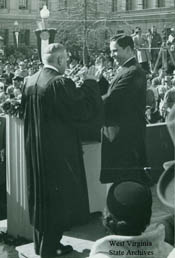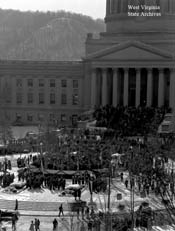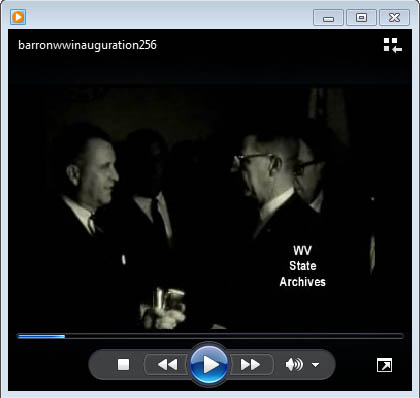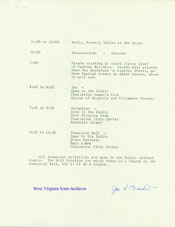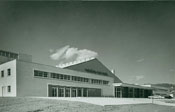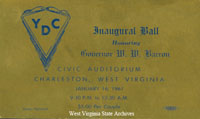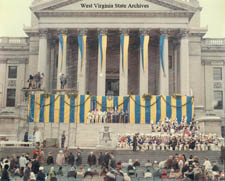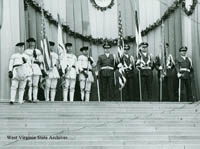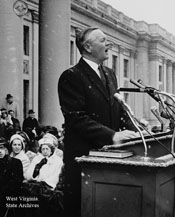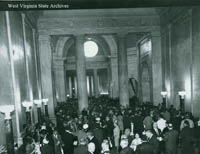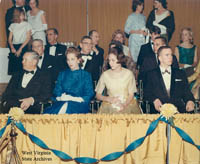

Chapter Six | ||||||||||||||||||||||
 Governor William C. Marland |
Beginning one hour before the start of the formal ceremony inaugurating William Casey Marland on January 19, 1953, four high school bands performed outside the capitol, each at a different entrance. Three of the bands (Mullens, Oceana, and Pineville) were from Marland's home county of Wyoming. The fourth band was the Elkhorn High School band from McDowell County. | 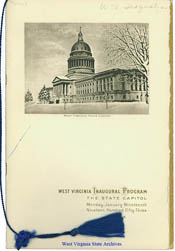 Excerpts from Marland's inaugural program |
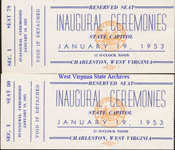 Inaugural tickets. |
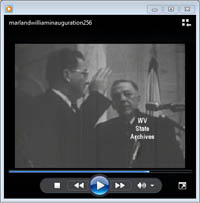 Inaugural footage. |
Although weather conditions would have permitted the inauguration to be held outdoors, the ceremony was planned as an indoor event. Marland was not inaugurated in the Senate chamber, however. Instead, the event took place in the capitol rotunda, with Marland and other dignitaries seated on a two-story platform under the dome and more than two thousand seats filling the legislative corridors. Among those seated on the platform were former Governor Henry D. Hatfield, United Mine Workers President John L. Lewis, and UMWA District 17 President William Blizzard.
Ceremonies began at noon with the playing of the national anthem, the invocation, and the singing of "The Lord's Prayer" by young Julliard-trained tenor James L. Bailey of Charleston. After taking the oath of office, Governor Marland, who, in a departure from the formal morning attire of his predecessors, wore a dark blue suit, delivered his inaugural address. The inauguration was filmed, and, according to the Raleigh Register, film was to be flown to Huntington for airing on WSAZ-TV. A public reception was held in the governor's reception room in the evening. |
"Immediately after the inaugural, about 300 persons, . . ., strolled to the gubernatorial mansion for a luncheon and reception. A buffet-style luncheon was served.
The guests were served sliced Virginia ham, turkey and tomato aspic from a table banked with red and white carnations. Sweet potato balls were rolled in corn flakes and stuffed with marshmallows.
A string quartet played from the mansion's mezzanine.
Guests seated at six long tables in the dining room and adjoining rooms were served ice cream, covered with a replica of the American flag, for des[s]ert. ." |

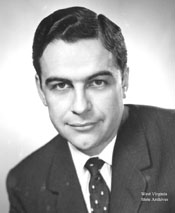 Governor Cecil H. Underwood
 Excerpts from Underwood's Inaugural Program |
In a move similar to that of Matthew Neely in 1941, Cecil Harland Underwood was administered the oath of office at 12:06 a.m. on Monday, January 14, 1957, in the Hotel Kanawha by Wayman R. Brown, a notary public and agent for Columbian Fuel Corporation. In order to have the oath officially filed, Brown and others then visited Secretary of State D. Pitt O'Brien, administered the oath to him, and had him sign Underwood's oath.
Shortly after 10:00 a.m., the inaugural parade began, traveling east on Kanawha Boulevard from Summers Street to the capitol. Although 23 bands had been planned, weather made several late and kept some from arriving at all. Temperatures were below freezing, and several inches of snow had fallen overnight. A few participants slipped and fell on the icy ground during the parade. A reviewing stand had been erected across the boulevard from the capitol for Underwood and other dignitaries. WCHS-TV and WSAZ-TV covered the parade, and WSAZ-TV provided the first live television coverage of the inauguration of a West Virginia governor. At the end of the parade, Underwood entered the capitol only to exit on the other side of the building, where a platform had been constructed over the fountain. After the new governor took the oath of office for the second time, the West Virginia National Guard gave a 19-gun salute before Underwood gave his inaugural address. Before the benediction, Prince A. Williams, a music professor at West Virginia State College, sang "Onward Christian Soldiers." The formal ceremonies ended and the governor held a reception for the high school musicians who had participated in the parade, the first and only time that such an event was held as part of a gubernatorial inauguration. The students also were provided a box lunch. Starting at 8:00 p.m. that evening, a public reception was held in the governor's reception room; the Underwood's three-year-old daughter Cecelia had her own receiving line for several very young attendees. Afterwards, a semi-formal dance, sponsored by the Young Republicans, was held at the Daniel Boone Hotel. |
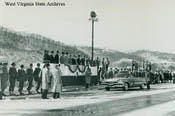 Reviewing stand during the inaugural parade.
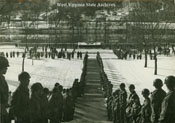 View toward reviewing stand. |

Inaugural footage (no audio)
Four years later, on January 16, 1961, Underwood's successor also chose to take the oath at a midnight ceremony. At 12:02 a.m. William Wallace Barron was administered the oath of office by Secretary of State Joe Burdett in the Board of Public Works board room. Members of the West Virginia Highlanders from Elkins, Barron's hometown, set off cannon fire at the riverbank, and Barron signed into law a temporary increase in the sales tax. After the fact, the midnight ceremony was repeated for television and radio crews.
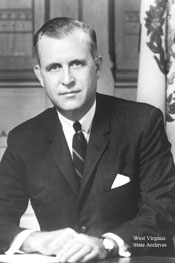 Governor William W. Barron
 Excerpts from Barron's Inaugural Program |
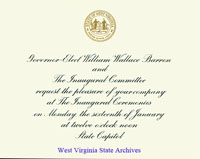 Invitation to inaugural ceremonies. Twelve hours later, Barron took the oath of office a second time during the formal inaugural ceremonies and gave his inaugural address before a crowd of between two and three thousand people who had filled the second-floor rotunda of the capitol. Barron and more than ninety other individuals were on a temporary platform built in the rotunda, much like the one Marland had used eight years earlier. Among those on the platform were the new governor's wife Opal and three daughters and former governors Homer Holt and Okey Patteson. Between Barron's oath and speech, three 105 howitzers on the statehouse lawn provided a 19-gun salute. In what appears to be a first, a member of the Jewish religion, Rabbi Samuel Cooper of Charleston, gave the invocation.
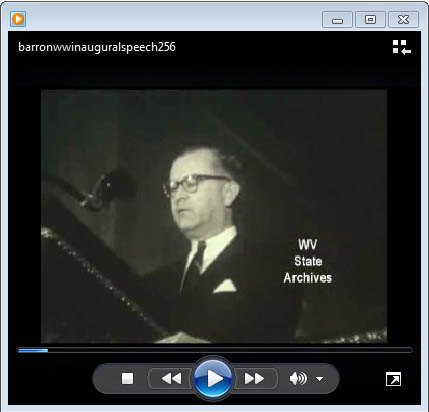 Barron inaugural speech footage |
 Ticket to inaugural ceremonies.
|
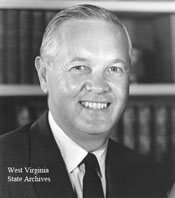 Governor Hulett C. Smith
 Excerpts from Smith's Inaugural Program |
On a cold, snowy January 18, 1965, Hulett Carlson Smith ascended to the office of governor. Despite the weather, the inauguration was held outdoors on the steps to the north portico. Eight television stations and 21 radio stations planned to carry the event, many of them live.
High school bands from Frankford, Matewan, and St. Marys played before the formal ceremonies. The invocation, singing of the national anthem, and, for the first time at an inauguration, singing of the "West Virginia Hills, one of the three official state songs, began the ceremonies. In a change from previous inaugurations, one that would be followed in all future inaugurations, the oath of office was administered to other state officials before the governor took his oath. Then, members of the First Reconnaisance Squadron, 150th Armored Cavalry, West Virginia National Guard, fired the 19-gun salute with M41 tanks. Smith's inaugural address was followed by the benediction. |
|
||||



